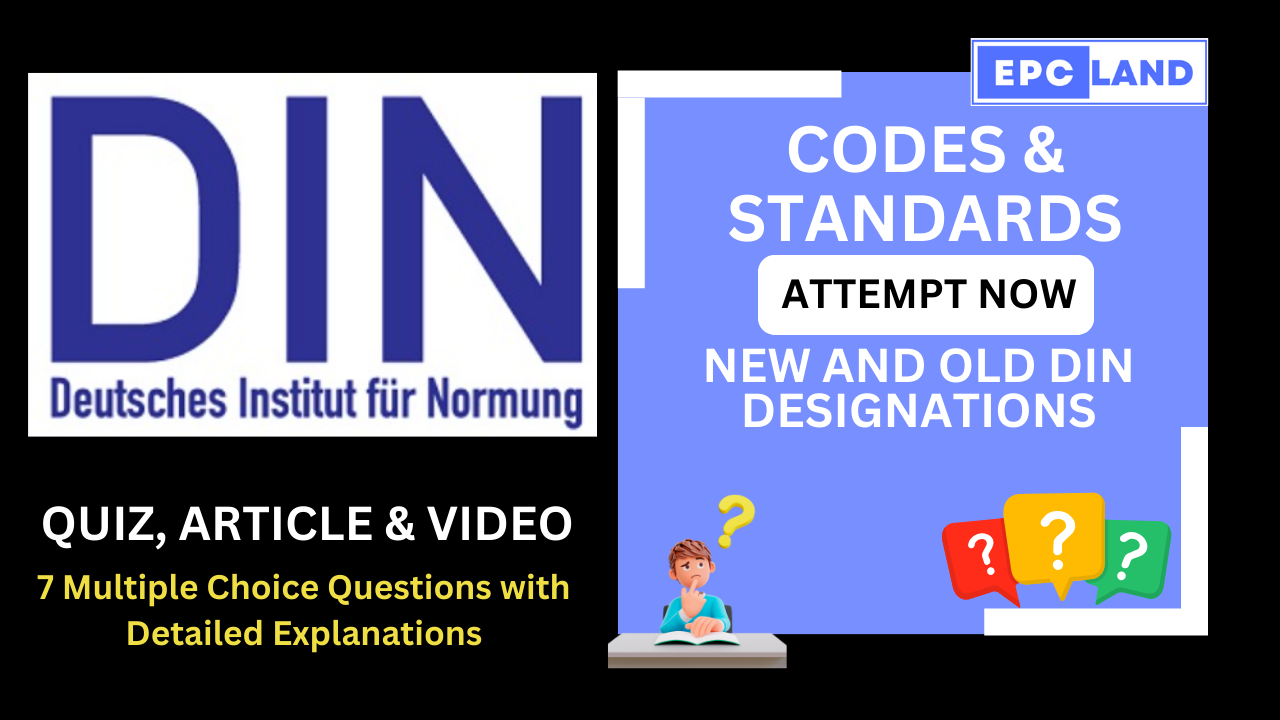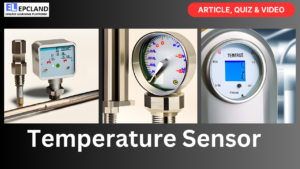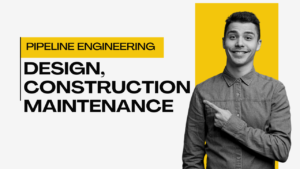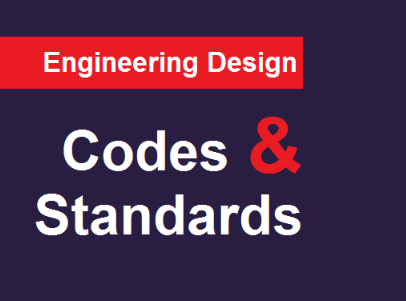
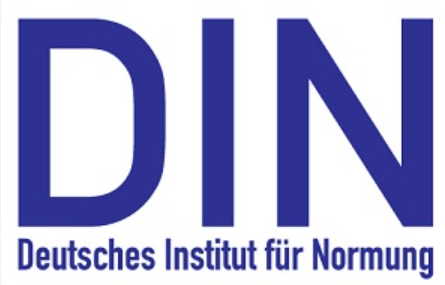
1. New and Old DIN Designations: What does the letter “P” signify in the new DIN EN system for pipes?
Choose the correct answer w.r.t. New and Old DIN Designations:
Explanation: The letter “P” in the new DIN EN system signifies pressure pipes, indicating their application for conveying fluids under pressure.
2. Which series replaces old standards like DIN 1629 and 17175 for pressure pipes in the new system?
Choose the correct answer:
Explanation: The EN 10216 series replaces old standards like DIN 1629 and 17175 for pressure pipes in the new DIN EN system.
3. What do DIN 17120 and 17121 refer to, and what are their replacements in the new system?
Choose the correct answer:
Explanation: DIN 17120 and 17121, which refer to construction pipes, are replaced by DIN EN 10210 and 10219 in the new system.
4. What is the replacement series for old DIN standards like DIN 2605, 2615, 2616, and 2617 for butt-welding pipe fittings?
Choose the correct answer:
Explanation: DIN 2605, 2615, 2616, and 2617 are replaced by DIN EN 10253 series for butt-welding pipe fittings in the new system.
5. What is the replacement series for old DIN flange standards like DIN 2513, 2526, and 2527 in the new system?
Choose the correct answer:
Explanation: Old DIN flange standards like DIN 2513, 2526, and 2527 are replaced by DIN EN 1092 series for circular flanges in the new system.
6. What is the significance of the letter “P” in the new system for pipes?
Choose the correct answer:
Explanation: In the new DIN EN system, the letter “P” signifies pressure pipes, indicating their application for conveying fluids under pressure.
7. What is the current status of API standards for pipeline applications according to the information provided?
Choose the correct answer:
Explanation: According to the information provided, API standards for pipeline applications remain valid for now, indicating that they are still in effect.
25+ Relevant topics on Codes & Standards
Short Article on Codes & Standards

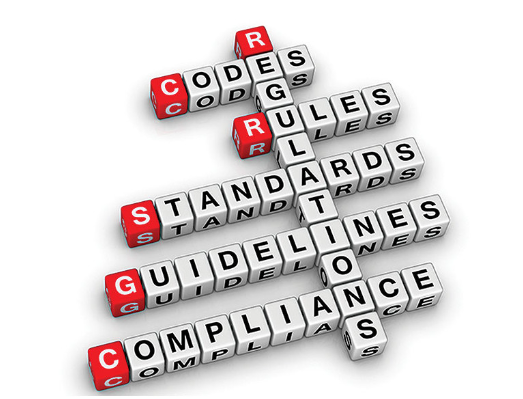
New and Old DIN Designations: A Comprehensive Breakdown
This article sheds light on the evolution of DIN standards for pipes, fittings, and flanges, highlighting the transition from old designations to the new EN and DIN EN system. Here’s a breakdown of the key points:
Old vs. New System:
- Many old DIN standards like DIN 1629, 17175, and 17121 have been replaced by Euronorms with distinct designations for different applications (pressure, construction, pipelines).
- The new system uses “P” for pressure pipes, followed by a number indicating minimum yield strength and additional letters for specific properties (e.g., P235TR2).
Pressure Pipes:
- EN 10216 series replaces old standards like DIN 1629 and 17175.
- Different parts cover non-alloy pipes at room/elevated temperatures and alloy fine grain steel pipes.
- Examples: EN 10216-1 P235TR2 (formerly DIN 1629, St.37.0), EN 10216-2 P235GH (formerly DIN 17175, St.35.8 Cl. 1).
Construction Pipes:
- DIN 17120 and 17121 are replaced by DIN EN 10210 and 10219.
- These standards specify technical delivery conditions for hot-finished and cold-formed welded structural hollow sections.
- Examples: DIN EN 10210-1/2 S235JRH, DIN EN 10219-1/2 S355J2HS.
Pipeline Pipes:
- Replaced by DIN EN 10208, with three parts specifying technical conditions for pipes of different requirement classes.
- Examples: DIN EN 10208-2 L245NB, DIN EN 10208-2 L360NB (replacing API 5L grades).
Fittings:
- DIN 2605, 2615, 2616, and 2617 replaced by DIN EN 10253 series for butt-welding pipe fittings.
- Different parts cover carbon steel, non-alloy and ferritic alloy steel, and austenitic stainless steels.
Flanges:
- Old DIN 2513, 2526, 2527, etc. replaced by DIN EN 1092 series for circular flanges.
- Different parts cover steel, cast iron, copper alloy, and aluminium alloy flanges with specific PN designations and pressure/temperature ratings.
Additional Notes:
- API standards for pipeline applications remain valid for now.
- The document provides detailed descriptions of each relevant DIN EN standard and its corresponding old designation.
Overall, this information helps engineers, manufacturers, and other stakeholders navigate the transition from old DIN standards to the new harmonized system, ensuring accurate selection of suitable materials for various applications.
I hope this summary clarifies the information presented in the article. Feel free to ask any further questions you may have about specific standards or their applications!
Table of Contents
Don’t miss the Course on Effective Isometrics Management: Check Now
Enrollment Link
Recommended courses (Published on EPCLand)
- Complete Course on Piping Engineering
- Basics of Piping Engineering
- Piping Layout Engineering
- Piping Material Engineering
- Piping Stress Analysis
- Material Requisitions
- Piping Material Specifications
- Valve Material Specifications
- Plant Design & Layouts-OISD 118
- Isometric Management
Library of Technical Articles
Don’t miss out the collection of 15+ articles on following topics:
- Basics of Oil and Gas Industry
- Valves
- Testing
- Tank
- Piping Bulk Items
- Pipe
- Metallurgy
- Piping Materials
- Layout
- Instrumentation
- Heat Exchanger
- Type of Contracts
- Codes and Standards
- ASTM Standards
- Articles on Piping Specialty Items
Video details of Complete Course on Piping Engineering
Why Enroll in the EPCLand
Proven Track Record– PTR
Activities & Achievements before launching EPCLand
- Published more than 50+ short courses
- 3000+ Enrolments
- More than 3,500,00 Minutes of watch hours in the last 2 years
- 4000+ Students in 100+ Countries
- Rating of 4+ out of 5
- 1000+ YouTube Videos
- 8K+ Subscribers
What Students will Learn
- Codes & Standards of the Energy Sector
- Piping Material Engineering
- Piping Layout Engineering
- Stress Analysis
Interesting facts
- All the published courses have been developed by Industry Experts with more than 2 decades of experience
- Content is based on Practical experience and real-time problems.
- Content is designed and organized in such a manner that it can be easily grabbed.
- Complete website, Blogs and Quiz sections are Planned, Designed and published by myself (About me: Atul Singla)
- Complete flexibility of Time & Location, Students can access the content from anywhere & anytime
- Moreover, once enrolled, the content can be access as many times as you want, which helps in understand the fundamentals in a better way.
Conclusion
In conclusion, our courses are meticulously crafted by industry experts with over two decades of hands-on experience. The content is rooted in practical knowledge, addressing real-time problems. The material is thoughtfully designed and organized for easy comprehension. Every aspect, from the website to blogs and quizzes, has been planned, designed, and executed by Atul Singla, ensuring a comprehensive and seamless learning experience. With the flexibility of accessing the content at any time and from any location, students have the freedom to learn on their terms. Furthermore, enrollment grants unlimited access, allowing learners to revisit the material as often as needed, fostering a deep understanding of the fundamentals.
